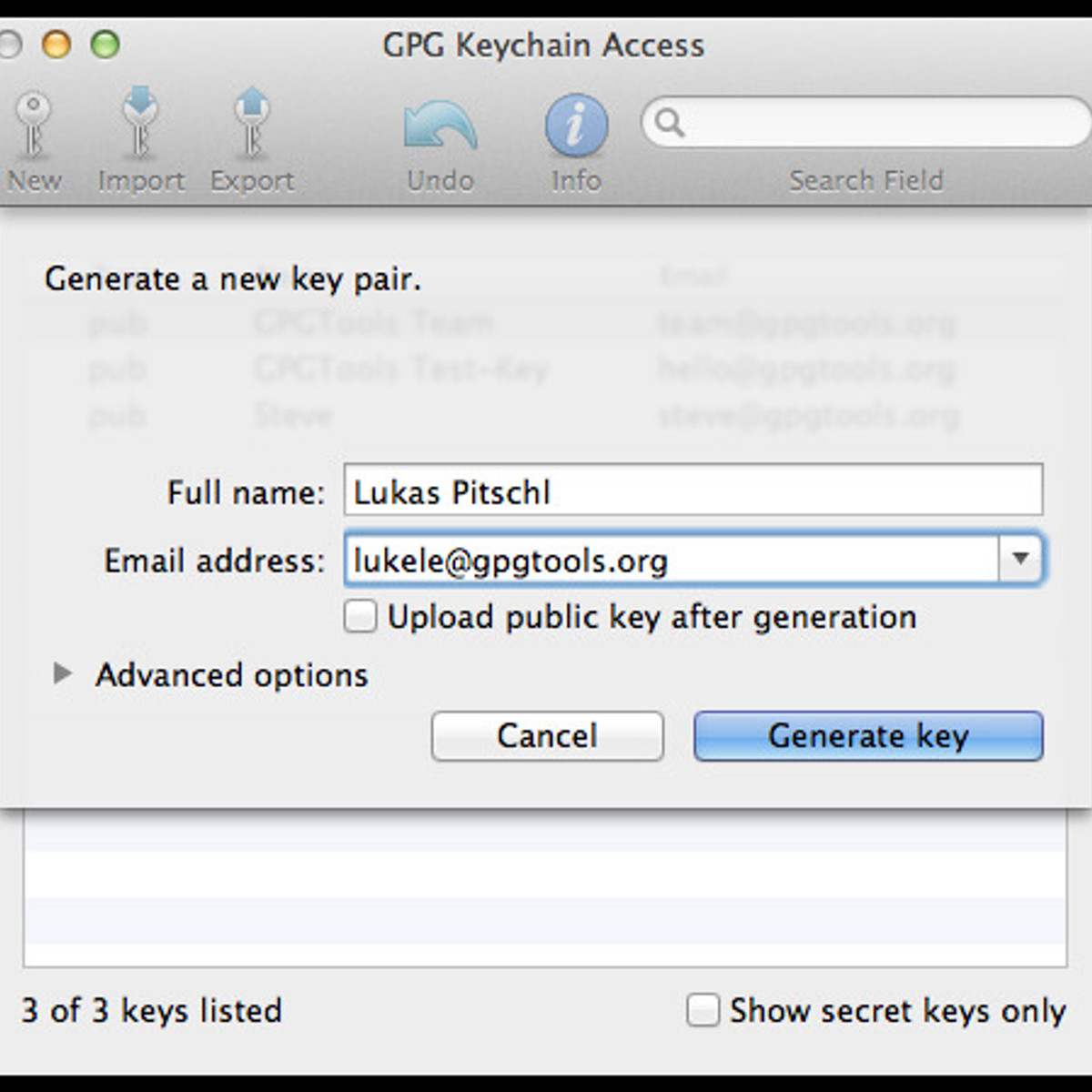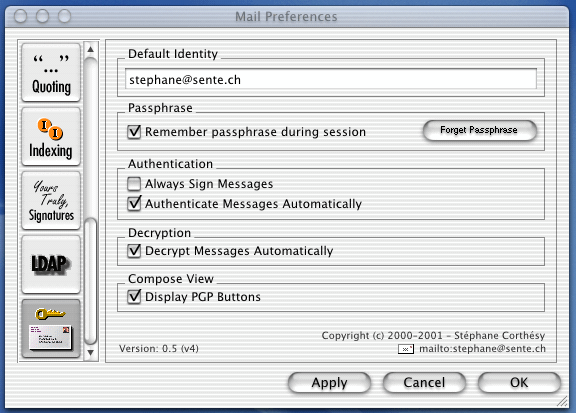- GnuPG allows to encrypt and sign your data and communication, features a versatile key.
- When Mozilla Thunderbird launches for the first time, Mac OS X will ask you if you are sure you want to open it. Mozilla Thunderbird was downloaded from mozilla.org and should be safe, click the “Open” button. Mozilla Thunderbird can integrate with the Mac OS X address book, we leave this choice to you.
OpenPGP is the most widely used email encryption standard. It is defined by the OpenPGP Working Group of the Internet Engineering Task Force (IETF) as a Proposed Standard in RFC 4880.OpenPGP was originally derived from the PGP software, created by Phil Zimmermann. GnuPG 1.4 is the old, single binary version which still support the unsafe PGP-2 keys. This branch has no dependencies on the above listed libraries or the Pinentry. However, it lacks many modern features and will receive only important updates. OS X: Mac GPG: Installer from the gpgtools project. In the Mail app on your Mac, a Security field in the header area indicates whether a message is signed or encrypted. A signed icon (a checkmark) appears in the header area of a signed message. To view the certificate details, click the icon. If the message was altered after it was signed, Mail displays a warning that it can’t verify the message signature.
Despite the appearance of a number of good privacy-focused webmail services, Pretty Good Privacy (PGP) remains the gold standard of email encryption. In this guide, we show you how to use PGP on Mac, explain how it works and how secure PGP really is.
PGP does have a number of issues (discussed below), but it is still the most widely used email encryption system, and therefore the most interoperable with others no matter which platform or email service they use.
It can also be used for signing and encrypting all sorts of other stuff but is mainly used to secure emails.
How does PGP work?
The details of how PGP works are, to be honest, rather complicated. The important thing to remember, however, is that PGP uses public-key cryptography.
Each user has a private key which they keep secret and use to decrypt emails sent to them using their public key. They also have a public key, which they freely so that other people can use it to send them encrypted emails.
- Private key – kept secret and used to decrypt own mail
- Public key – distributed so that others can use it to encrypt mail for sending to you
For this tutorial, we’ll stick to how to use PGP for encrypting emails, but PGP keypairs are also very useful for signing and verifying digital signatures.

PGP vs OpenPGP
When discussing PGP these days we almost always mean OpenPGP. This is an open-source 100% compatible clone of the original PGP, which is now closed-source software owned by Symantec.
Issues with PGP
When PGP is used to secure emails, the metadata - such as email addresses of both the sender and recipient, date and time of sending, and e-mail’s subject line - is not encrypted. Just the body text and any attachments.
Another problem with PGP is that it does not use Perfect Forward Secrecy (PFS). So once keys for one encrypted email are broken, all other emails encrypted using the same keys will also be compromised.
Arguably the biggest problem with PGP, though, is that it's just not very easy to use, with the result being that most people simply don’t. To combat this, we will show you the two easiest ways to use PGP on your Mac:
Method 1: Malivelope
Mailvelope is a free and open-source browser extension for Chrome and Firefox that makes using PGP on your Mac about as easy as PGP is ever likely to get. Please check out our full Mailvelope How-to guide for a detailed look at how it works.
Method 2: GPGTools with GPG Mail
The most common implementation of OpenPGP is Privacy Guard (also known as GnuPG or just GPG). GPG on its own is a basic command-line tool, but GPGTools for macOS provides a GUI interface and advanced features.
It is worth noting that in 2018 GPGTools make headlines due its vulnerability to the EFAIL attack which affected all versions of PGP at the time. Since GPGTools 2018.2, however, this vulnerability has been patched.
GPGTools is free, but the GPG Mail plugin for Apple Mail is designed to help fund the open-source project and costs $22. This is a one-off fee, but you do need to pay again for new versions as they are released.
Download and install the GPG Suite.
Do please make sure to verify the download before installing it. During installation, stick with all the default settings.
Create a new keypair
.Open the GPG Keychain app, select New (the + sign) and fill in the relevant details. You can leave the Advanced options alone or play with them as you please.
Upload your public key to a keyserver.
This will allow others to find it using your email address so that they can send you secure PGP-encrypted emails.
Do please be aware, though, that once a public key is uploaded to a keyserver it cannot be deleted. The keyserver will send you an email asking you to confirm the upload.
You will see your newly created key in the GPG Keychain.
If you already have a keypair then you can import it by clicking the Import button. You can then right-click on it -> Send Public Key to Keyserver.
Send an encrypted email.
In order to send a PGP-encrypted email, you will need the recipient's public key. If they have already sent it to you (as an email attachment, for example) then you can import it using GPG Keychain.
If you already have it, then you can search by email address for public keys that have been uploaded to a key server. Once you have found the key you want, simply import it into your GPG Keychain.
Open the Apple Mail app. If you're using an up-to-date version of macOS (10.14 Mojave+), you will need to enable GPG in Mail. To do this, Go to Preferences -> General -> Manage Plug-ins and enable the GPGMailLoader.mailbundle plug-in.
Then simply compose an email as normal, ensuring that OpenPGP is selected in the new green drop-down button to the top right of the compose screen.
When you have finished writing your message you can sign and/or encrypt it using the two buttons to the right of the Subject line:
A) Sign - this verifies that the email was sent by yourself. When GPG Mail is installed, all messages are signed by default (button is blue). Click on the button to turn signing off.
B) Encrypt - encrypts the content of the message plus any attachments. It does not encrypt the subject line or hide any other metadata. Click the lock icon (turning it blue) to encrypt your email.
Hit Send, and you will be asked for the password to your PGP key. If you are worried that an adversary may gain physical access to your Mac, then you should untick “Save in Keychain.”
Receive encrypted messages
When you receive PGP email that has been encrypted and/or signed with your public key, GPG Mail will automatically decrypt it and/or verify the signature using your private key.
Verify and sign keys
For maximum security, you should verify and sign keys. You verify a key by comparing the fingerprint you have of the key with the fingerprint owned by the sender to ensure they are identical. Ideally, this is done face-to-face, but a secure communication channel such as Signal Messenger will suffice.
Each imported key’s fingerprint is prominently displayed in GPG Keychain.
Once you are satisfied with the authenticity of a key, you can sign-it to confirm that you consider it valid. PGP works on a chain of trust, so you can opt to publish your signature in order to help others decide if the key is authentic.
And that’s the basic outline of how to use GPGTools to send and receive PGP emails in macOS. GPGTools has more tricks up its sleeve, however, which we may explore in future articles.
ProPrivacy only uses basic cookies to monitor traffic to the site. Is that okay?
Find out how to manage cookies and view our policy here
ProPrivacy does not use marketing cookies
- Fastest VPN we test
- Servers in 94 countries
- Unblocks Netflix, iPlayer and more
Pgp Solution For Mac Os X

 Get ExpressVPN
Get ExpressVPN Pgp Desktop For Mac Os X
30-Day Money-Back Guaranteewasn't right for you?
Pgp For Mac Os X 10.7
We recommend you check out one of these alternatives: